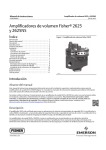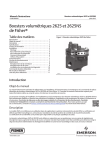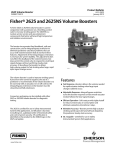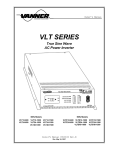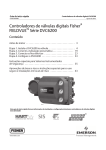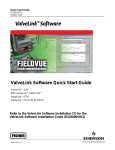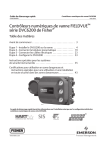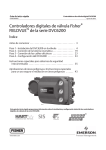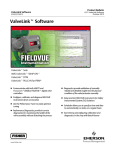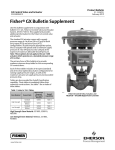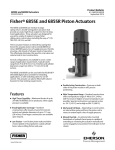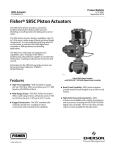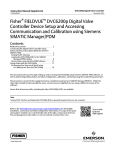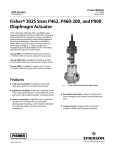Download Emerson Fisher VBL Volume Booster Instruction Manual
Transcript
Instruction Manual VBL Volume Booster D103317X012 February 2014 Fisherr VBL Volume Booster Contents Introduction . . . . . . . . . . . . . . . . . . . . . . . . . . . . . . . . . Scope of Manual . . . . . . . . . . . . . . . . . . . . . . . . . . . . . Description . . . . . . . . . . . . . . . . . . . . . . . . . . . . . . . . . Specifications . . . . . . . . . . . . . . . . . . . . . . . . . . . . . . . Educational Services . . . . . . . . . . . . . . . . . . . . . . . . . Installation . . . . . . . . . . . . . . . . . . . . . . . . . . . . . . . . . . Mounting . . . . . . . . . . . . . . . . . . . . . . . . . . . . . . . . . . Pressure Connections . . . . . . . . . . . . . . . . . . . . . . . . Supply Pressure . . . . . . . . . . . . . . . . . . . . . . . . . . . . . Exhaust Ports . . . . . . . . . . . . . . . . . . . . . . . . . . . . . . . Operating Information . . . . . . . . . . . . . . . . . . . . . . . . . Principle of Operation . . . . . . . . . . . . . . . . . . . . . . . . . Maintenance . . . . . . . . . . . . . . . . . . . . . . . . . . . . . . . . . Figure 1. Fisher VBL Volume Booster 1 1 1 2 2 4 4 5 5 5 6 7 8 X0648 Introduction Scope of Manual This instruction manual provides installation, operation, maintenance, and parts information for the Fisher VBL volume booster (figure 1). Refer to separate instruction manuals for information regarding the valve body, actuator, and other accessories. Do not install, operate, or maintain a VBL volume booster without being fully trained and qualified in valve, actuator and accessory installation, operation and maintenance. To avoid personal injury or property damage it is important to carefully read, understand, and follow all of the contents of this manual, including all safety cautions and warnings. If you have any questions about these instructions, contact your Emerson Process Management sales office before proceeding. Description The VBL volume booster is used in conjunction with a positioner on a throttling control valve to increase stroking speed. The booster has a fixed deadband (controlled by the seat‐to‐seat dimension of the supply and exhaust plugs) which is factory set during assembly and testing. In addition, the booster incorporates soft‐seat construction and an integral bypass restriction to eliminate positioner saturation problems that can occur with volume boosters that do not have these features. Adjustment of the integral bypass restriction is necessary for system stability. This adjustment does not affect the deadband of the booster, but does permit the control valve to respond to small input signal changes from the positioner without sacrificing steady‐state accuracy. www.Fisher.com VBL Volume Booster Instruction Manual February 2014 D103317X012 It also allows the booster to deliver high‐volume output for fast stroking when large, rapid input signal changes occur. The volume booster is used to improve stroking speed. If precision valve control is required, the use of a positioner is recommended. If you use the volume booster only with an actuator, for on‐off control, the integral bypass restriction on the volume booster must be closed (turned fully clockwise). To facilitate diagnostic testing, you can install connectors and piping with the VBL volume booster. The O‐rings and diaphragms in the VBL volume booster are HNBR (Hydrogenated Nitrile). HNBR demonstrates excellent temperature capability and shelf life over standard nitrile. Specifications Specifications for the VBL volume booster are listed in table 1. Information for an individual unit as it comes from the factory appears on the nameplate. Educational Services For information on available courses for the VBL volume booster, as well as a variety of other products, contact: Emerson Process Management Educational Services, Registration P.O. Box 190 Marshalltown, IA 50158-2823 Phone: 800-338-8158 or 641-754-3771 FAX: 641-754-3431 e-mail: [email protected] 2 Instruction Manual VBL Volume Booster D103317X012 February 2014 Table 1. Specifications Input Signal Positioner output Connections Maximum Input Signal Pressure(1) VBL-1 and VBL-3: 5.5 bar (80 psig) VBL-2 and VBL-4: 10.3 bar (150 psig) Input to Output Pressure Ratio Fixed at 1 to 1 Supply Pressure Ranges(1) When used in conjunction with a positioner or other pneumatic accessory, always pipe the positioner and booster with one common supply through a Fisher 67D, 67DR, or 95H regulator (see figure 4). A high‐capacity filter, such as the Fisher 262K, should be installed in the supply line to the regulator. Supply pressure also must not exceed the maximum pressure rating of the actuator. Input Signal: 1/4 NPT Supply and Output Signal: 1/2 NPT Hazardous Area Classification Complies with the requirements of ATEX Group II Category 2 Gas and Dust Approximate Weight Aluminum Body: 1.0 kg (2.2 pounds) Declaration of SEP Operative Temperature Limits(1) -40 to 93_C (-40 to 200_F) Fisher Controls International LLC declares this product to be in compliance with Article 3 paragraph 3 of the Pressure Equipment Directive (PED) 97 / 23 / EC. It was designed and manufactured in accordance with Sound Engineering Practice (SEP) and cannot bear the CE marking related to PED compliance. Maximum Flow Coefficients See table 2 However, the product may bear the CE marking to indicate compliance with other applicable European Community Directives. NOTE: Specialized instrument terms are defined in ANSI/ISA Standard 51.1 - Process Instrument Terminology. 1. The pressure/temperature limits in this document, and any applicable code or standard limitation should not be exceeded. Table 2. Maximum Flow Coefficients Instrument Supply Port Coefficients Exhaust Port Coefficients Cv Cv VBL‐1 volume booster 2.5 1.1 VBL-2 volume booster 2.5 1.1 VBL‐3 volume booster 2.5 1.8 VBL-4 volume booster 2.5 1.8 FIELDVUEt DVC6200, DVC6200 SIS, DVC6200f, DVC6200p, DVC6000, DVC6000 SIS, DVC6000f digital valve controllers 0.37 0.31 FIELDVUE DVC2000 digital valve controller Low pressure relay High pressure relay Fisher 3570 valve positioner 0.13 0.19 0.25 0.15 0.20 0.25 Fisher 3582 valve positioner 0.17 0.19 Fisher 3610J, 3610JP, 3611JP, 3620J, 3620JP, 3621JP valve positioners 0.37 0.30 3 VBL Volume Booster Instruction Manual February 2014 D103317X012 Installation WARNING Always wear protective clothing, gloves, and eyewear when performing any installation procedures to avoid personal injury. System damage may result if a volume booster is installed in a way that it can be physically damaged. Personal injury or system damage may result when service conditions exceed booster or other equipment ratings. Exceeding the pressure specifications in table 1 may cause leakage, parts damage, or personal injury due to bursting of pressure‐containing parts or explosion of accumulated gas. Check with your process or safety engineer for any additional measures that must be taken to protect against process media. Note Do not use separate pressure supplies for the volume booster and associated positioner. The volume booster may not exhaust immediately upon loss of a separate pressure supply. However, if the system is in a transient state at the time of pressure supply loss or if changes to the booster's input signal are sufficient to overcome the deadband, the booster will exhaust. A loss of a pressure supply (either separate or common) to a Fisher 3582 or 3610J positioner will cause the positioners output pressure (booster's input pressure) to decay. Always pipe the positioner and the volume booster with one common supply. See figure 4 for typical installation examples. A 67D, 67DR, or 95H regulator is required to provide sufficient capacity to supply both components. A high‐capacity filter, such as the 262K, should be installed in the supply line to the regulator. Mounting The volume booster is typically nipple‐mounted between the pneumatic supply source and the actuator, and may be used with piston or diaphragm actuators. Many actuators require larger casing or cylinder connections and modifications to allow the booster to deliver the higher volume output. The booster may also be directly mounted to the actuator by using an actuator yoke mounting bracket (see figure 2) or casing mounting bracket. If a mounting bracket is used, remove the appropriate end cap screws and install the mounting bracket. Install the end cap screws, re‐tightening to a recommended torque value of 12.5 NSm (110 lbfSin). 4 Instruction Manual VBL Volume Booster D103317X012 February 2014 Figure 2. Volume Booster with Yoke Mounting Bracket HEX SCREW (QTY 6) HEX SCREW (QTY 6) ATTACH THIS SURFACE TO ACTUATOR YOKE YOKE MOUNTING BRACKET YOKE MOUNTING BRACKET GE26237-Bracket Pressure Connections The input signal connection is 1/4 NPT. The supply and output connections are 1/2 NPT (minimum pipe size recommended for nipple mounting is 1/2 NPT). Connections to the volume booster should be made as indicated in figure 3. Connections for typical applications are shown in figures 4 and 5. Ensure that the piping is of proper size to meet the capacity demands of the booster and that you equip the actuator with properly sized input connections. Supply Pressure Supply pressure must be filtered, clean, dry air or noncorrosive gas. WARNING If a flammable or hazardous gas is to be used as the supply pressure medium, personal injury, property damage or equipment damage could result from fire or explosion of accumulated gas or from contact with hazardous gas. The volume booster has no provision for piping away the vented exhaust gas. Therefore, do not use flammable or otherwise hazardous gas as a supply medium unless the unit is in a well‐ventilated area and all ignition sources have been removed. Exhaust Ports Exhaust to the atmosphere is through exhaust ports in the side of the unit. Keep the exhaust ports free of any obstructions or foreign materials that might clog them. 5 Instruction Manual VBL Volume Booster D103317X012 February 2014 Operating Information The only operating requirement of the volume booster is the adjustment of the bypass restriction for stable actuator performance. Although systems with different characteristics may require different adjusting techniques, the following adjustment procedure is recommended when using the actuator for throttling control. Note When sizing the booster, select the lowest Cv that will meet the stroking speed specifications. Oversizing the booster in a closed loop may lead to stability problems, thus requiring the bypass to be opened so far that the booster will never operate. Prior to operation, turn the bypass restriction adjusting screw (figure 3) four or five turns counterclockwise from the fully closed position. With the actuator in operation, slowly turn the restriction clockwise until the booster operates in response to large changes in the input signal, yet allows small changes to move the actuator without initiating booster operation. Figure 3. Volume Booster Sectional View SPRING SEAT UPPER SPRING HOUSING, TOP EXHAUST PORT HEX NUT INPUT SIGNAL HEX SCREW UPPER DIAPHRAGM BYPASS RESTRICTION ADJUSTING SCREW DIAPHRAGM SPACER PIN, SLOTTED SPRING BYPASS VALVE O‐RING HOUSING, BOTTOM SUPPLY O‐RING END CAP DIAPHRAGM PLATE ASSEMBLY (INCLUDES LOWER DIAPHRAGM) EXHAUST SUPPLY PORT OUTPUT TO ACTUATOR LOWER SPRING VALVE PLUG ASSEMBLY LUBRICANT GE26237-Section If the actuator is to be used for on‐off control, the restriction should be closed (turned fully clockwise). Verify that the capacity of the regulator meets the stroking capacity requirements. 6 Instruction Manual VBL Volume Booster D103317X012 February 2014 Principle of Operation Refer to figures 3, 4, and 5. Because of the restriction, large input signal changes register on the booster input diaphragm sooner than in the actuator. A large, sudden change in the input signal causes a pressure differential to exist between the input signal and the output of the booster. When this occurs, the diaphragms move to open either the supply port or the exhaust port, whichever action is required to reduce the pressure differential. The port remains open until the difference between the booster input and output pressures returns to within the deadband limits of the booster. With the bypass restriction adjusted for stable operation, signals having small magnitude and rate changes pass through the bypass restriction and into the actuator without initiating booster operation. Both the supply and exhaust ports remain closed, preventing unnecessary air consumption and possible saturation of positioner relays. Figure 4. Typical Installations with Piston Actuator PIPE NIPPLE VBL VOLUME BOOSTER SUPPLY SIGNAL TOP CYL BOTTOM CYL 67D, 67DR OR 95H REGULATOR ACTUATOR POSITIONER E1212 7 Instruction Manual VBL Volume Booster D103317X012 February 2014 Figure 5. Typical Installations with Diaphragm Actuator VBL VOLUME BOOSTER PIPE NIPPLE SUPPLY SIGNAL 67D, 67DR OR 95H REGULATOR ACTUATOR E1213 DVC6200 DIGITAL VALVE CONTROLLER WITH RELAY C OR POSITIONER Maintenance There are no repairable or replaceable parts on the VBL volume booster. Contact your Emerson Process Management sales office if a replacement VBL volume booster is needed. Neither Emerson, Emerson Process Management, nor any of their affiliated entities assumes responsibility for the selection, use or maintenance of any product. Responsibility for proper selection, use, and maintenance of any product remains solely with the purchaser and end user. Fisher is a mark owned by one of the companies in the Emerson Process Management business unit of Emerson Electric Co. Emerson Process Management, Emerson, and the Emerson logo are trademarks and service marks of Emerson Electric Co. All other marks are the property of their respective owners. The contents of this publication are presented for informational purposes only, and while every effort has been made to ensure their accuracy, they are not to be construed as warranties or guarantees, express or implied, regarding the products or services described herein or their use or applicability. All sales are governed by our terms and conditions, which are available upon request. We reserve the right to modify or improve the designs or specifications of such products at any time without notice. Emerson Process Management Marshalltown, Iowa 50158 USA Sorocaba, 18087 Brazil Chatham, Kent ME4 4QZ UK Dubai, United Arab Emirates Singapore 128461 Singapore www.Fisher.com 8E 2010, 2014 Fisher Controls International LLC. All rights reserved.










